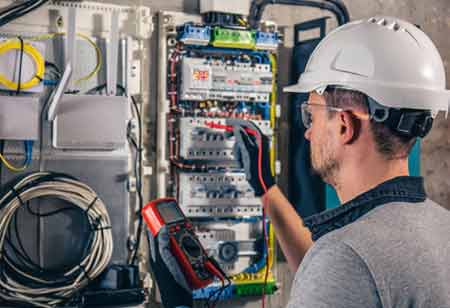

I agree We use cookies on this website to enhance your user experience. By clicking any link on this page you are giving your consent for us to set cookies. More info
Thank you for Subscribing to Electrical Business Review Weekly Brief

Regular electrical testing is crucial for commercial buildings to ensure safety, efficiency, and compliance with codes and regulations. It also identifies fire hazards, minimizes shocks, optimizes energy usage, and prevents tragedies.
At the core of every commercial building lies a complex ecosystem of wires, circuits, and electrical panels. This unseen network powers everything from lighting and computers to vital machinery and security systems. Like any complex system, electrical installations are susceptible to wear and tear, damage, and code violations. Regular electrical testing becomes essential to ensure commercial properties' safety, efficiency, and smooth operation. Prioritizing Safety The most compelling reason for regular electrical testing is the paramount concern for safety. Faulty wiring, overloaded circuits, and outdated equipment can all pose significant fire risks. A single spark can ignite a blaze, endangering the lives of employees, customers, and visitors. Regular testing by qualified electricians can identify these hazards before they escalate, preventing potential tragedies and fostering a safe working environment. Electrical testing also mitigates the risk of electrical shocks. Damaged insulation or loose connections can create pathways for electricity to flow where it shouldn't. Testing helps uncover these issues, preventing severe injuries and providing peace of mind for everyone within the building. Optimizing Efficiency: Powering Up the Bottom Line Regular electrical testing isn't just about safety but smart business practices. Faulty or outdated electrical systems can be significant energy hogs. Worn-down equipment and overloaded circuits consume more power than necessary, driving utility bills. By identifying these inefficiencies through testing, informed decisions about repairs, upgrades, or replacements can be made. This reduces energy consumption and translates to significant cost savings over time. Modern testing methods, like infrared thermography, can pinpoint areas where heat buildup indicates potential problems. This proactive approach allows issues to be addressed before they lead to costly equipment failures or downtime. Maintaining Compliance: Staying on the Right Side of the Law Electrical codes and regulations are constantly evolving to ensure the safety of electrical systems. Regular testing by certified professionals guarantees that commercial buildings adhere to these latest standards. This mitigates the risk of fines or penalties and demonstrates a commitment to responsible building management. In the unfortunate event of an electrical fire or accident, having up-to-date testing records can serve as crucial documentation, potentially mitigating legal liabilities. Beyond the Basics: A Proactive Approach to Electrical Wellness Regular electrical testing shouldn't be viewed as a one-time fix. It's an ongoing process that contributes to electrical systems' overall health and longevity. By establishing a routine testing schedule, minor issues can be identified and addressed before they snowball into major problems. This proactive approach minimizes the risk of disruptions and ensures the smooth operation of business activities. Regular electrical testing for commercial properties is a non-negotiable investment. It safeguards the well-being of occupants, optimizes energy usage, and ensures compliance with regulations. A secure and productive environment for business operations can be created by prioritizing electrical safety and efficiency.